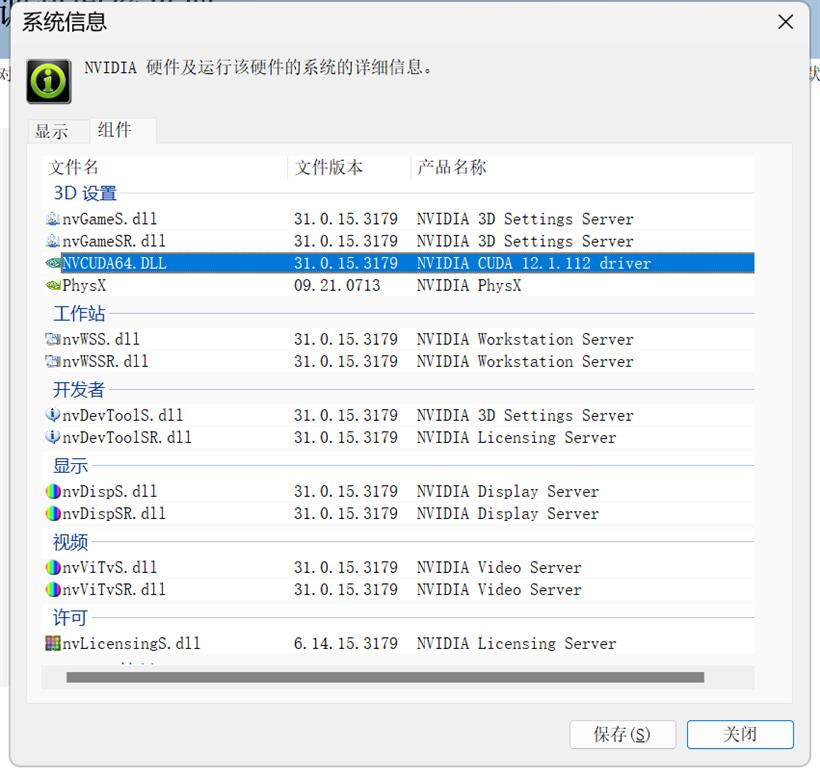- 联系我们
- duidaima.com 版权声明
- 闽ICP备2020021581号
-
 闽公网安备 35020302035485号
闽公网安备 35020302035485号
 闽公网安备 35020302035485号
闽公网安备 35020302035485号

https://www.paddlepaddle.org.cn/documentation/docs/zh/install/Tables.html#ciwhls-release
https://developer.nvidia.com/cuda-toolkit-archivecudnn8.4安装包下载地址:
https://developer.nvidia.com/rdp/cudnn-archive首先安装CUDA11.6,安装完成后,解压cudnn8.4压缩包,将解压后的文件拷贝到CUDA11.6安装目录中即可,CUDA安装路径是:
C:\Program Files\NVIDIA GPU Computing Toolkit\CUDA\v11.6随后需要将bin目录添加到系统的环境变量中:
C:\Program Files\NVIDIA GPU Computing Toolkit\CUDA\v11.6\bin接着在终端进入demo文件夹:
C:\Program Files\NVIDIA GPU Computing Toolkit\CUDA\v11.6\extras\demo_suite执行bandwidthTest.exe命令,返回:
C:\Program Files\NVIDIA GPU Computing Toolkit\CUDA\v11.6\extras\demo_suite>bandwidthTest.exe [CUDA Bandwidth Test] - Starting... Running on... Device 0: NVIDIA GeForce RTX 4060 Laptop GPU Quick Mode Host to Device Bandwidth, 1 Device(s) PINNED Memory Transfers Transfer Size (Bytes) Bandwidth(MB/s) 33554432 12477.8 Device to Host Bandwidth, 1 Device(s) PINNED Memory Transfers Transfer Size (Bytes) Bandwidth(MB/s) 33554432 12337.3 Device to Device Bandwidth, 1 Device(s) PINNED Memory Transfers Transfer Size (Bytes) Bandwidth(MB/s) 33554432 179907.9 Result = PASS NOTE: The CUDA Samples are not meant for performance measurements. Results may vary when GPU Boost is enabled.即代表安装成功,随后可通过deviceQuery.exe查询GPU设备:
C:\Program Files\NVIDIA GPU Computing Toolkit\CUDA\v11.6\extras\demo_suite>deviceQuery.exe
deviceQuery.exe Starting...
CUDA Device Query (Runtime API) version (CUDART static linking)
Detected 1 CUDA Capable device(s)
Device 0: "NVIDIA GeForce RTX 4060 Laptop GPU"
CUDA Driver Version / Runtime Version 12.1 / 11.6
CUDA Capability Major/Minor version number: 8.9
Total amount of global memory: 8188 MBytes (8585216000 bytes)
MapSMtoCores for SM 8.9 is undefined. Default to use 128 Cores/SM
MapSMtoCores for SM 8.9 is undefined. Default to use 128 Cores/SM
(24) Multiprocessors, (128) CUDA Cores/MP: 3072 CUDA Cores
GPU Max Clock rate: 2370 MHz (2.37 GHz)
Memory Clock rate: 8001 Mhz
Memory Bus Width: 128-bit
L2 Cache Size: 33554432 bytes
Maximum Texture Dimension Size (x,y,z) 1D=(131072), 2D=(131072, 65536), 3D=(16384, 16384, 16384)
Maximum Layered 1D Texture Size, (num) layers 1D=(32768), 2048 layers
Maximum Layered 2D Texture Size, (num) layers 2D=(32768, 32768), 2048 layers
Total amount of constant memory: zu bytes
Total amount of shared memory per block: zu bytes
Total number of registers available per block: 65536
Warp size: 32
Maximum number of threads per multiprocessor: 1536
Maximum number of threads per block: 1024
Max dimension size of a thread block (x,y,z): (1024, 1024, 64)
Max dimension size of a grid size (x,y,z): (2147483647, 65535, 65535)
Maximum memory pitch: zu bytes
Texture alignment: zu bytes
Concurrent copy and kernel execution: Yes with 1 copy engine(s)
Run time limit on kernels: Yes
Integrated GPU sharing Host Memory: No
Support host page-locked memory mapping: Yes
Alignment requirement for Surfaces: Yes
Device has ECC support: Disabled
CUDA Device Driver Mode (TCC or WDDM): WDDM (Windows Display Driver Model)
Device supports Unified Addressing (UVA): Yes
Device supports Compute Preemption: Yes
Supports Cooperative Kernel Launch: Yes
Supports MultiDevice Co-op Kernel Launch: No
Device PCI Domain ID / Bus ID / location ID: 0 / 1 / 0
Compute Mode:
< Default (multiple host threads can use ::cudaSetDevice() with device simultaneously) >
deviceQuery, CUDA Driver = CUDART, CUDA Driver Version = 12.1, CUDA Runtime Version = 11.6, NumDevs = 1, Device0 = NVIDIA GeForce RTX 4060 Laptop GPU
Result = PASS
至此,CUDA和cudnn就配置好了。python -m pip install paddlepaddle-gpu==2.4.2.post116 -f https://www.paddlepaddle.org.cn/whl/windows/mkl/avx/stable.html这里安装paddlepaddle的gpu版本,版本号是2.4.2.post116,2.4是最新版,其中116就代表Cuda的版本,注意版本一定不能弄错。
git clone https://gitee.com/PaddlePaddle/PaddleGAN运行命令本地编译安装PaddleGan项目:
pip install -v -e .随后再安装其他依赖:
pip install -r requirements.txt这里有几个坑,需要说明一下:
pip uninstall numpy随后安装1.21版本:
pip install numpy==1.21接着在Python终端中验证PaddleGan是否安装成功:
import paddle paddle.utils.run_check()如果报这个错误:
PreconditionNotMetError: The third-party dynamic library (cudnn64_7.dll) that Paddle depends on is not configured correctly. (error code is 126)
Suggestions:
1. Check if the third-party dynamic library (e.g. CUDA, CUDNN) is installed correctly and its version is matched with paddlepaddle you installed.
2. Configure third-party dynamic library environment variables as follows:
- Linux: set LD_LIBRARY_PATH by `export LD_LIBRARY_PATH=...`
- Windows: set PATH by `set PATH=XXX; (at ..\paddle\phi\backends\dynload\dynamic_loader.cc:305)
[operator < fill_constant > error]
则需要下载cudnn64_7.dll动态库,然后复制到CUDA11.6的bin目录中,动态库地址后面会贴出来。Python 3.10.11 (tags/v3.10.11:7d4cc5a, Apr 5 2023, 00:38:17) [MSC v.1929 64 bit (AMD64)] on win32 Type "help", "copyright", "credits" or "license" for more information. >>> import paddle >>> paddle.utils.run_check() Running verify PaddlePaddle program ... W0517 20:15:34.881800 31592 gpu_resources.cc:61] Please NOTE: device: 0, GPU Compute Capability: 8.9, Driver API Version: 12.1, Runtime API Version: 11.6 W0517 20:15:34.889958 31592 gpu_resources.cc:91] device: 0, cuDNN Version: 8.4. PaddlePaddle works well on 1 GPU. PaddlePaddle works well on 1 GPUs. PaddlePaddle is installed successfully! Let's start deep learning with PaddlePaddle now.说明大功告成,安装成功。

\PaddleGAN\applications\tools>将川普的静态图片和歌曲文件放入tools目录中。
python .\wav2lip.py --face .\Trump.jpg --audio test.wav --outfile pp_put.mp4 --face_enhancement这里--face是目标图片,--audio则是需要匹配唇形的歌曲,--outfile参数是输出视频。
